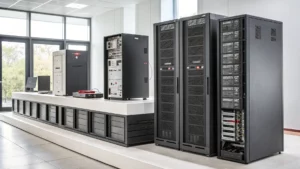Battery technology has undergone significant upgrades over the last century, evolving from bulky and inefficient designs to the more compact and powerful batteries we use today. Here’s a look at some key milestones:
Upgrades in the Last Century:
Early 20th Century: The nickel-iron battery, patented by Waldemar Jungner in 1899 and later improved by Thomas Edison around 1901, offered more durability than lead-acid batteries and found use in rail vehicles and mining.

Mid-20th Century: Nickel-cadmium (NiCd) batteries became popular for portable electronics due to their higher energy density compared to lead-acid.

Late 20th Century: The first commercial lithium-ion batteries were released by Sony in 1991. This marked a revolutionary shift, offering significantly higher energy density and longer life cycles, which fueled the boom in portable electronics like mobile phones and laptops.
Early 21st Century: Advancements in lithium-ion chemistry led to the development of various cathode materials like Nickel Manganese Cobalt (NMC), which offered higher energy densities and better thermal stability, becoming popular in electric vehicles (EVs). More recently, Lithium Iron Phosphate (LFP) batteries, developed in 1996, are gaining prominence due to their improved safety, longer lifespan, and lower cost, even if their energy density is slightly lower.

The Future of Battery Technology in the Next Decade:
The next decade promises even more exciting advancements in battery technology, driven by the growing demand for electric vehicles, portable electronics, and grid-scale energy storage. Here are some key trends and potential developments:
Solid-State Batteries: These are considered a “holy grail” for battery technology, replacing the liquid electrolyte with a solid material (like ceramic, polymers, or glass). They offer the potential for higher energy density (2-3 times that of lithium-ion), improved safety (non-flammable), faster charging times, and longer lifespans. Many companies and research institutions are heavily invested in scaling up the production of solid-state batteries, and they are expected to capture a significant share of the EV battery market by 2030 (potentially around 15%).
Sodium-Ion Batteries: As a more cost-effective alternative to lithium-ion batteries, sodium-ion technology is gaining traction. Sodium is abundant and more evenly distributed than lithium, leading to lower material costs and reduced supply chain risks. While their energy density is currently lower than lithium-ion, they are suitable for applications like grid-scale energy storage and potentially some electric vehicles, with predictions suggesting they could capture around 10% of the battery market by 2030. https://lithiuminverter.in/news/tianneng-pioneers-solid-state-battery-revolution-for-future-mobility/
Lithium-Sulfur (Li-S) Batteries: These batteries offer the potential for significantly higher energy density than lithium-ion, which could dramatically increase the range of electric vehicles and improve energy storage capacity. Sulfur is also a more affordable and abundant material. However, challenges like corrosion and cycle life need to be overcome for widespread commercialization.
Silicon Anodes: Replacing some or all of the graphite in lithium-ion battery anodes with silicon can increase energy density, leading to longer-lasting devices. Silicon-doped graphite is already entering the market, and further innovations in silicon anodes are expected.
Advanced Cathode Materials: Ongoing research focuses on developing new cathode materials, such as high-nickel NMC and Lithium Nickel Cobalt Aluminum Oxide (NCA), to improve energy density and reduce the reliance on expensive and ethically sourced materials like cobalt.
Cobalt-Free Lithium-Ion Batteries: Reducing or eliminating cobalt from lithium-ion batteries is a major focus due to its high cost and ethical concerns. Researchers are exploring various cobalt-free alternatives to make batteries more sustainable and affordable.
Battery Management Systems (BMS) and AI: Advancements in BMS, enhanced by Artificial Intelligence (AI), will play a crucial role in optimizing battery performance, safety, and lifespan. AI algorithms can analyze vast amounts of data to improve battery design, predict lifespan, and enhance charging and discharging strategies.
Battery Recycling: With the increasing volume of batteries reaching the end of their life, significant advancements in battery recycling technologies will be crucial for creating a sustainable battery lifecycle and recovering valuable materials.
In summary, the last century witnessed a remarkable evolution in battery technology, with lithium-ion batteries revolutionizing portable electronics and electric vehicles. The next decade promises even more transformative changes with the potential commercialization of solid-state, sodium-ion, and lithium-sulfur batteries, along with advancements in materials science, battery management, and recycling, paving the way for a more electrified and sustainable future.




